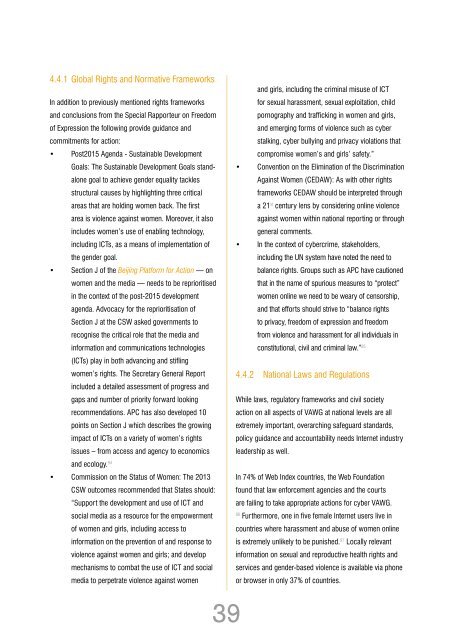CYBER VIOLENCE AGAINST WOMEN AND GIRLS
cyber_violence_gender%20report
cyber_violence_gender%20report
Create successful ePaper yourself
Turn your PDF publications into a flip-book with our unique Google optimized e-Paper software.
4.4.1 Global Rights and Normative Frameworks<br />
In addition to previously mentioned rights frameworks<br />
and conclusions from the Special Rapporteur on Freedom<br />
of Expression the following provide guidance and<br />
commitments for action:<br />
• Post2015 Agenda - Sustainable Development<br />
Goals: The Sustainable Development Goals standalone<br />
goal to achieve gender equality tackles<br />
structural causes by highlighting three critical<br />
areas that are holding women back. The first<br />
area is violence against women. Moreover, it also<br />
includes women’s use of enabling technology,<br />
including ICTs, as a means of implementation of<br />
the gender goal.<br />
• Section J of the Beijing Platform for Action — on<br />
women and the media — needs to be reprioritised<br />
in the context of the post-2015 development<br />
agenda. Advocacy for the reprioritisation of<br />
Section J at the CSW asked governments to<br />
recognise the critical role that the media and<br />
information and communications technologies<br />
(ICTs) play in both advancing and stifling<br />
women’s rights. The Secretary General Report<br />
included a detailed assessment of progress and<br />
gaps and number of priority forward looking<br />
recommendations. APC has also developed 10<br />
points on Section J which describes the growing<br />
impact of ICTs on a variety of women’s rights<br />
issues – from access and agency to economics<br />
and ecology. 94<br />
• Commission on the Status of Women: The 2013<br />
CSW outcomes recommended that States should:<br />
“Support the development and use of ICT and<br />
social media as a resource for the empowerment<br />
of women and girls, including access to<br />
information on the prevention of and response to<br />
violence against women and girls; and develop<br />
mechanisms to combat the use of ICT and social<br />
media to perpetrate violence against women<br />
and girls, including the criminal misuse of ICT<br />
for sexual harassment, sexual exploitation, child<br />
pornography and trafficking in women and girls,<br />
and emerging forms of violence such as cyber<br />
stalking, cyber bullying and privacy violations that<br />
compromise women’s and girls’ safety.”<br />
• Convention on the Elimination of the Discrimination<br />
Against Women (CEDAW): As with other rights<br />
frameworks CEDAW should be interpreted through<br />
a 21 st century lens by considering online violence<br />
against women within national reporting or through<br />
general comments.<br />
• In the context of cybercrime, stakeholders,<br />
including the UN system have noted the need to<br />
balance rights. Groups such as APC have cautioned<br />
that in the name of spurious measures to “protect”<br />
women online we need to be weary of censorship,<br />
and that efforts should strive to “balance rights<br />
to privacy, freedom of expression and freedom<br />
from violence and harassment for all individuals in<br />
constitutional, civil and criminal law.” 95<br />
4.4.2 National Laws and Regulations<br />
While laws, regulatory frameworks and civil society<br />
action on all aspects of VAWG at national levels are all<br />
extremely important, overarching safeguard standards,<br />
policy guidance and accountability needs Internet industry<br />
leadership as well.<br />
In 74% of Web Index countries, the Web Foundation<br />
found that law enforcement agencies and the courts<br />
are failing to take appropriate actions for cyber VAWG.<br />
96<br />
Furthermore, one in five female Internet users live in<br />
countries where harassment and abuse of women online<br />
is extremely unlikely to be punished. 97 Locally relevant<br />
information on sexual and reproductive health rights and<br />
services and gender-based violence is available via phone<br />
or browser in only 37% of countries.<br />
39


